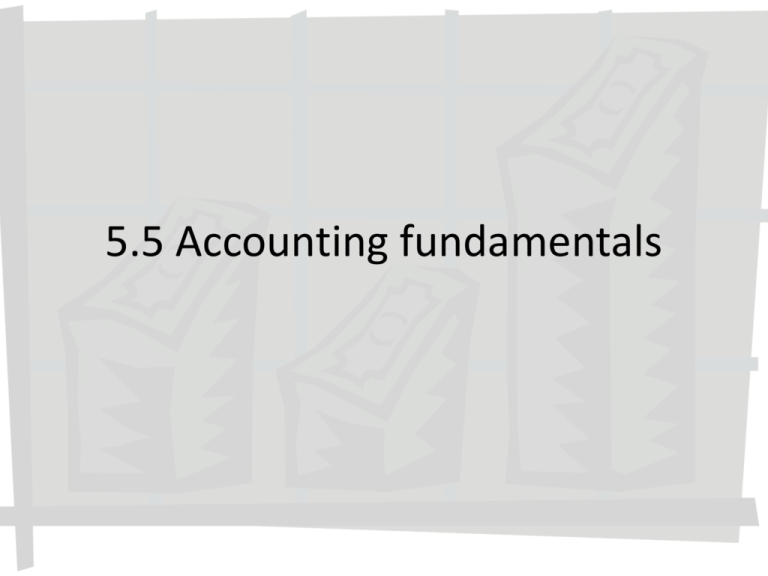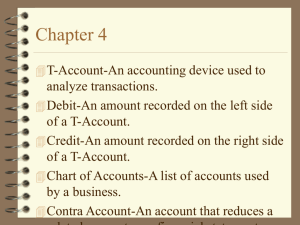5.5 Accounting fundamentals
advertisement

5.5 Accounting fundamentals Objectives • Why are financial accounts published? • Who wants to see the accounts and why? • What are the accounts? Why do companies publish accounts? • Forced to! • It is a legal requirement of Ltd and PLC companies to publish detailed and audited (checked) information regarding their company. • Okay; lets rephrase the question. Who wants to see the financial accounts and why? • Copy out the title. • Make a list of all the groups of people that would want to see the financial accounts of a business and why…… Who wants to see the financial accounts and why? Who wants to see the financial accounts and why? The Financial Accounts • There are three financial accounts that must be provided: – Income Statement (previously called profit and loss account). – Balance Sheet (soon to be called Statement of Financial Position). – Cash Flow Statement (not on syllabus and not to be confused with Cash Flow Forecast, which is). Income Statement Income Statement for XXXXXXXX for the year ending 1st April 2012 + Revenue 50,000 - Direct Costs (cost of sales) 20,000 = Gross Profit 30,000 - Indirect costs (expenses/overheads) 5,000 = Net Profit before interest and tax (PBIT) 25,000 - Interest on loans 15,000 = Net profit before tax (PBT) 10,000 - Tax 3,000 =Net profit after tax (PAT) 7,000 Dividends 3,000 Retained profit for year 4,000 (Dividends + retained profit for year = PAT) Income Statement • Look at your income statement! • Can you identify; – Revenue – direct costs – indirect costs – Interest paid – Tax – dividends Activities to understand accounts • Income Statement – You may find it useful to copy down the key definitions on pages 535 and 536 – Activity 29.3 page 537 Income Statement - Accruals • Income Statements record the profit or loss made in a 1 year period to a certain date. • ACCRUALS is also called the MATCHING CONCEPT. • Costs should be charged to the period in which the revenues that they generate are made. • Eg. Stock is bought, but not used until the next period. To which period should its cost be charged? • The period in which it is used. Income Statement - Accruals • Example: – A company starts a period with 250 units in stock. It buys 7,000 more units during the period. At the end of the period it has 300 units in a warehouse and 200 units on a lorry. – How many units should be charged to the period? – Activity 29.2 page 536 The Balance Sheet Balance Sheet for XXXXXXXXX as at 31st March 2012 Assets + Non-current assets (fixed assets) + Current Assets = Total Assets Equity and Liabilities + Current liabilities + Non-current liabilities = Total Liabilities + Share capital (shareholder initial investment) + Retained earnings = Total equity and liabilities Note: Total equity and liabilities = total assets 50,000 40,000 90,000 20,000 30,000 50,000 10,000 30,000 90,000 The Balance Sheet • Balance Sheets record all the assets, liabilities and equity held by a company at a particular date. • Its called the Balance Sheet as what the company owns (assets) must equal what it owes (liabilities + equity). FA + CA = CL + LL + Eq What the company owns (assets) must equal what it owes (liabilities + equity)! • This sounds insane! • However; – If the company makes a profit – The profit belongs to the company. – However, the company belongs to the shareholders. – Therefore, the profit is owned by the shareholders and, therefore, owed to them by the company. Lets do some maths!!! • From the balance sheet FA + CA = CL + LL + Eq • The chances are that your balance sheet is in a slightly different order. Maybe: FA+ CA –CL = LL + Eq Or FA + CA – CL - LL = Eq Activities to understand accounts • Balance Sheet – There is a list of key definitions on page 539. If you do not know any. Write them down now! – Activity 29.4 page 540 – Activity 29.5 page 543 Ratio Analysis • Ratio analysis = comparing one thing with something else. • Ratio analysis enables us to examine the accounts of a business and extract additional information. • Enables us to compare companies in the same business sector, but of different sizes, eg. Walmart and Wong, Toyota and Great Wall, Petrobras and Petro Peru. Ratio Analysis – Profitability Ratios • Gross Profit Margin • Net Profit Margin • Using page 544. – Copy the formulas for each margin and write your own definition for each. – Calculate the Gross and Net Profit Margin for your accounts. – Activity 29.7 page 549 Qs 1 to 3 only. • GPM= Gross Profit = Rev – Direct Costs Rev Rev • NPM= NP = Rev – Direct Costs - Indirect Costs Rev Rev Ratio Analysis – Liquidity • Recap: – Why is cash important? – Why is important not to have too much cash? – What is working capital? – How is working capital calculated? Liquidity Ratios • Liquidity = the ability of a company to pay its shortterm debts (current liabilities). • Liquidity Ratios = ratio of current assets to current liabilities • Current Ratio = Current Assets / Current Liabilities – Think about it this way … if all your current liabilities say pay us now! Can you? – The ideal level for the current ratio is 1.5 to 2. Although this will vary between industries. • Calculate the Current Ratio for your company for each year you have data. Liquidity Ratios 2 • Inventory is regarded as the least ‘liquid’ of the current assets. This means it is the most difficult to turn into cash. It is sometimes removed from the Current Ratio. • Acid-test (or quick) ratio= CA – Inventory CL – The ideal for the acid-test ratio is 1 (some textbooks write 1 to 1.5). Although this will vary between industries. • Calculate the Acid-test ratio for your company. Liquidity Ratio Activities • Activity 29.6 page 548 • Activity 29.7 page 549. You should already have completed 1 to 3.




